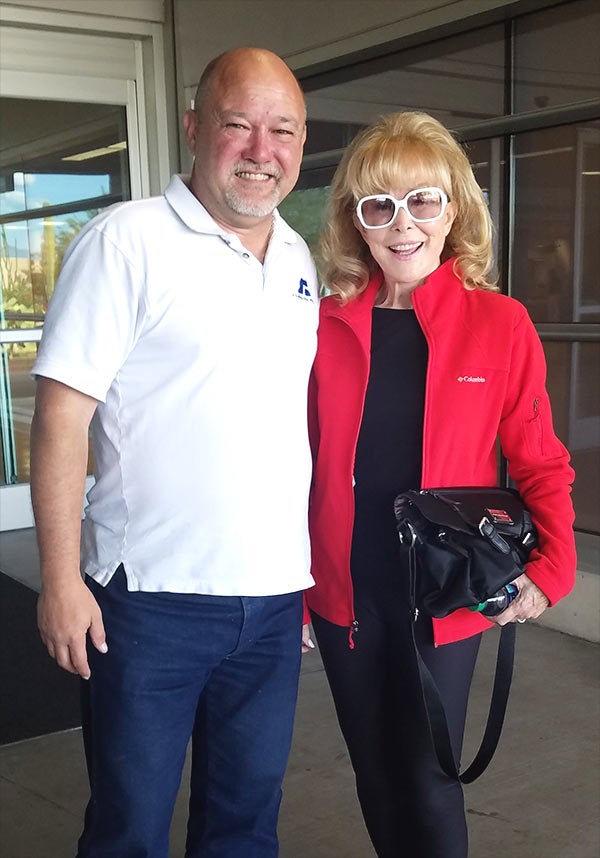University of California, Riverside
UCR on the
Silver Screen
Along with a plethora of faculty, alumni, and staff working in film and TV, the UCR campus has had several of its own moments in the Hollywood spotlight. Here’s a look at two of UCR’s most iconic starring roles.
If you’ve spent much time at UCR, you’re likely familiar with its distinctive midcentury architecture and covered archways. You may have strolled through the tranquil botanic gardens at the university’s eastern edge one time or another. But did you know the campus once doubled as a futuristic city home to a race of advanced, mutant superhumans? Or that the UCR Botanic Gardens was the backdrop for an uncharted jungle inhabited by a race of man-eating women? That’s right, UCR has had a starring — and sometimes unexpected — role in a slew of movies through the years. Here’s a look at a couple of the most iconic.
“Genesis II”
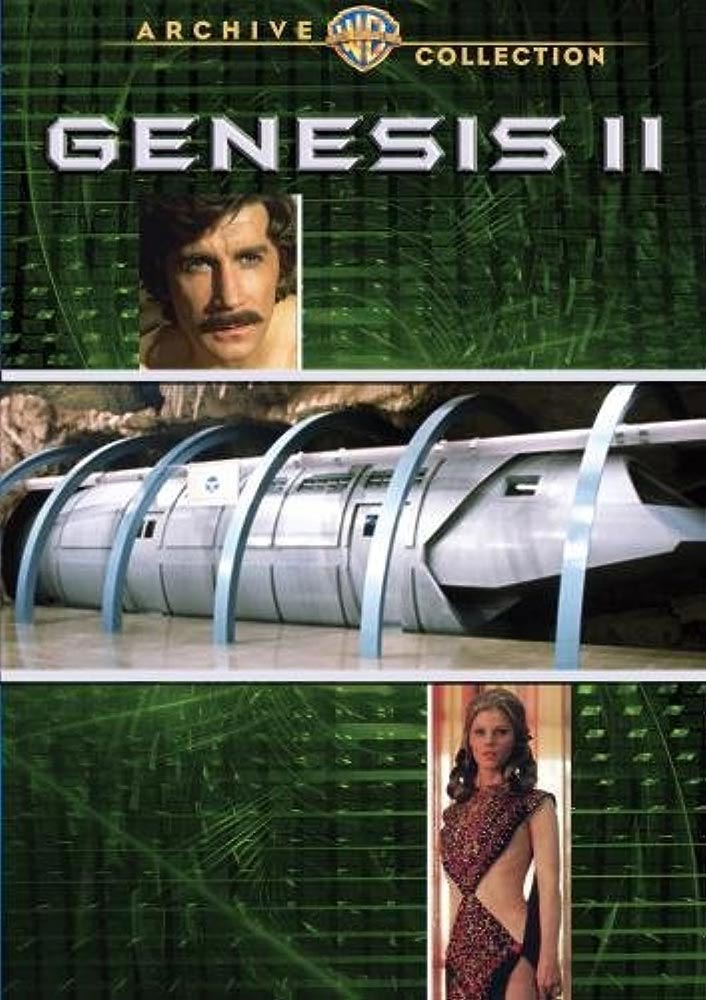
(“Genesis II”/Warner Bros.)
Following the cancellation of the original “Star Trek” TV show in 1969, series creator Gene Roddenberry was looking to make a comeback to the sci-fi genre with the post-apocalyptic epic “Genesis II.” The story follows Dylan Hunt, a NASA scientist who is buried in a testing facility deep in New Mexico’s Carlsbad Caverns during an earthquake in 1979 while testing a suspended animation system. Hunt is awakened when he is accidently discovered by a group of people living in the caverns, only to realize it is now the year 2133, over 150 years in the future. Starring Alex Cord, Mariette Hartley, and Ted Cassidy, the pilot for “Genesis II” aired on CBS as a made-for-TV movie in March 1973.
A key setting of the movie is the futuristic city Tyrania, home to a civilization of mutant humans, known as the Tyranians, who have evolved greater physical prowess than non-mutants and a dual circulatory system characterized by them having two navels. Incidentally, the advanced civilization of Tyrania happens to look a lot like UCR.
In a blog post from 2019, William Grover, a UCR associate professor of bioengineering, broke down pivotal scenes from “Genesis II” featuring the UCR campus. Here, Grover shares snippets from his blog, plus some updates and additional insight into this forgotten Roddenberry classic and UCR’s role in it.
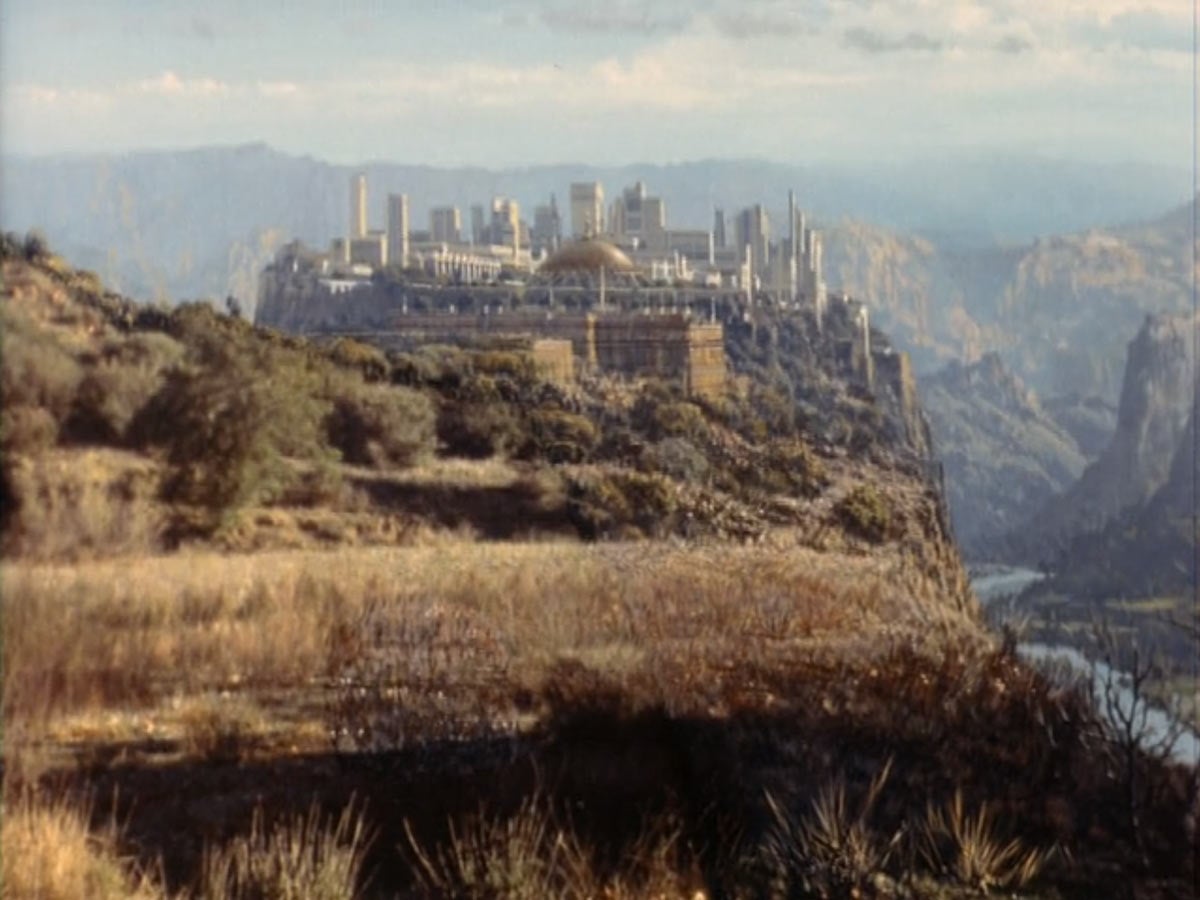
(“Genesis II”/Warner Bros.)
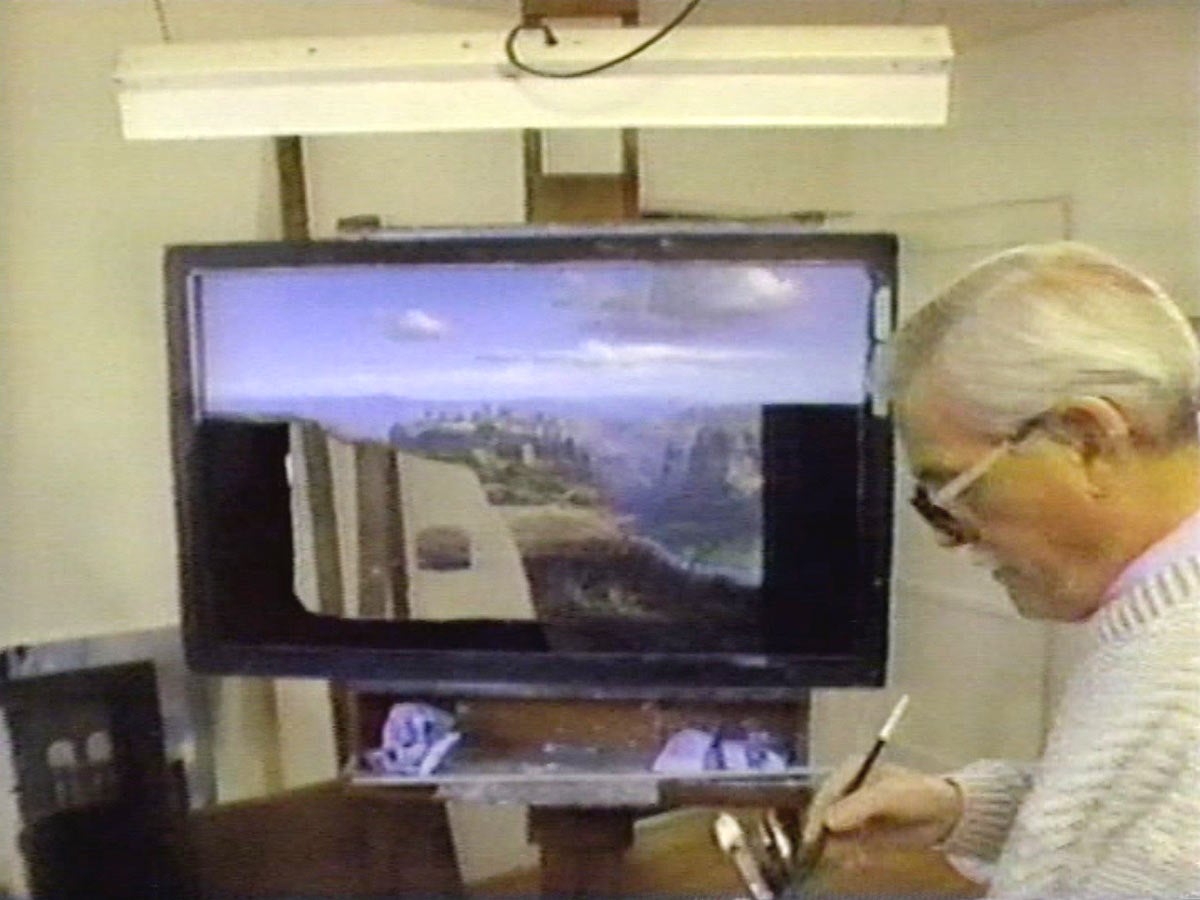
Whitlock seen in his studio working on the painting of Tyrania from the show “Only in Hollywood.” (Courtesy of Martin Nuetzel)
This shot is our first glimpse of Tyrania, seen from a distance as Dylan Hunt (Alex Cord) and Tyranian Lyra-a (Mariette Hartley) make their way to the futuristic city. Notably, it looks quite a bit different than the UCR campus. Following his blog post, Grover was contacted by Martin Nuetzel, a Gene Roddenberry historian and collector, who shared a shooting schedule for “Genesis II” detailing the movie’s filming locations.
“Martin’s shooting schedule says this was filmed at Fox Ranch,” Grover said. “The same place that the TV show M*A*S*H was shot!”
Nuetzal also shared the establishing shot of Tyrania was a matte painting created by two-time Academy Award winner Albert Whitlock Jr. Whitlock had worked for Roddenberry years earlier, creating the matte paintings used on Star Trek.
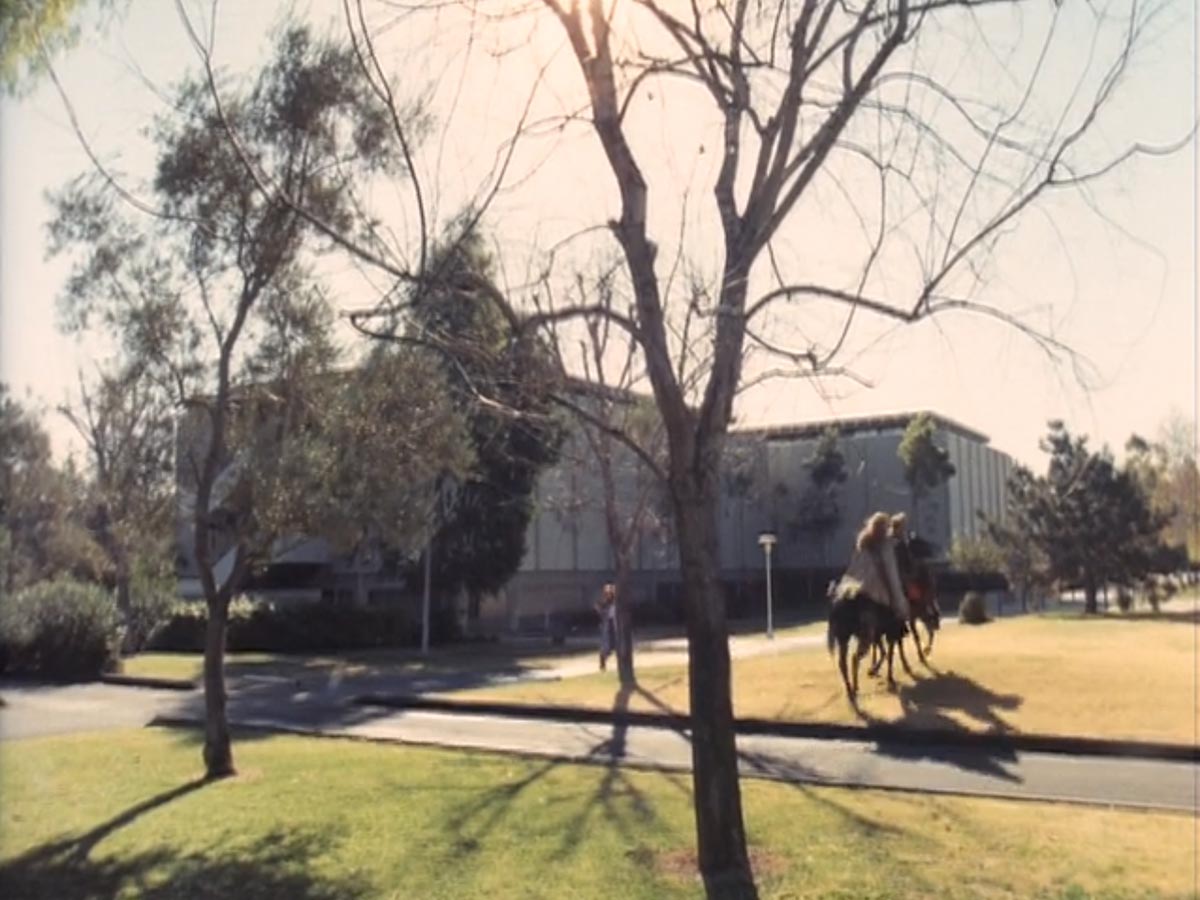
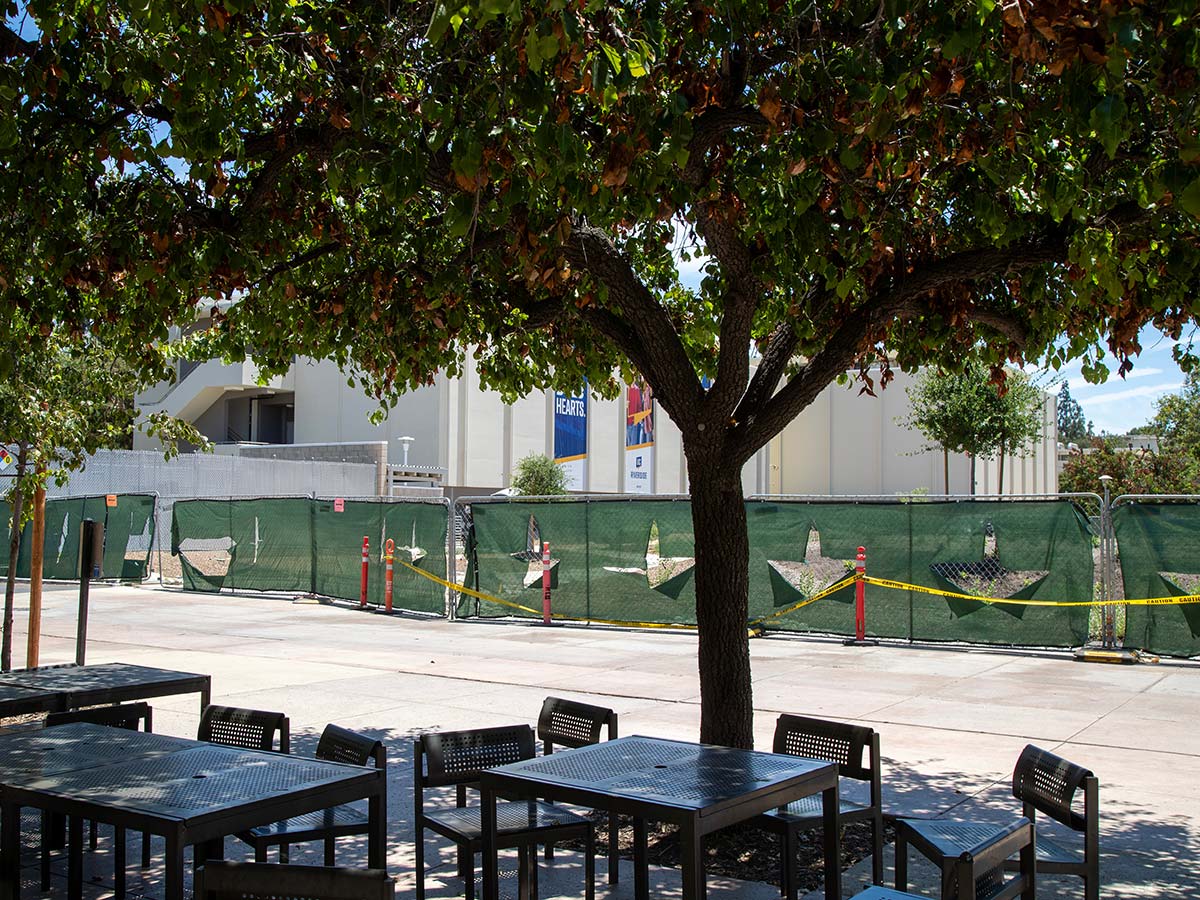
(“Genesis II”/Warner Bros. | UCR/Stan Lim)
In this scene, Hunt and Lyra-a first ride into Tyrania — and past Pierce Hall. Grover notes in his blog how scenes like this one show how much campus has changed during the past 50 years, as the tree-studded lawn at the beginning of the clip is long gone, now replaced by the Bourns College of Engineering. The above images show Pierce Hall as seen in the film and today.
“The grassy area in front of Pierce in the later portion of the clip is still an open area today,” Grover added. “However, it’s currently being converted to a Native American Landscape Garden.”
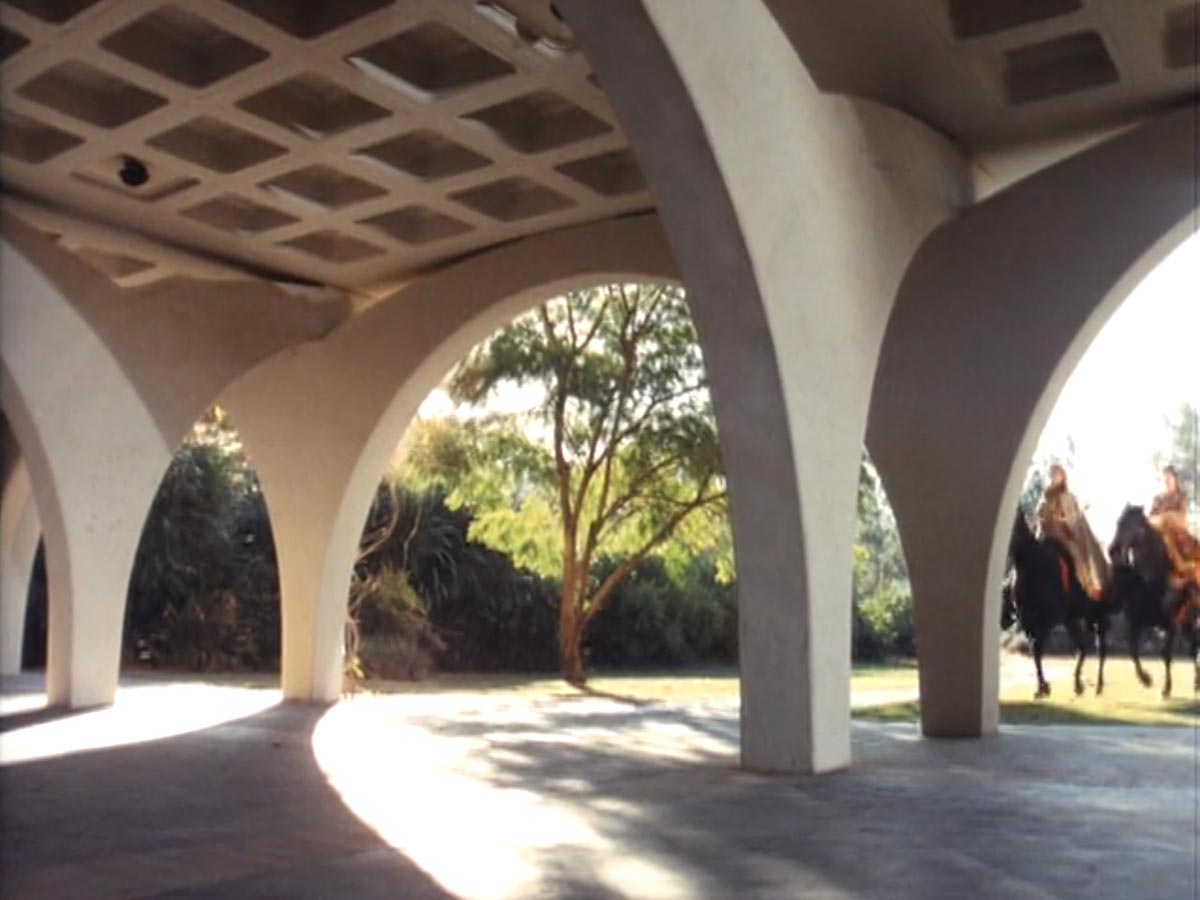
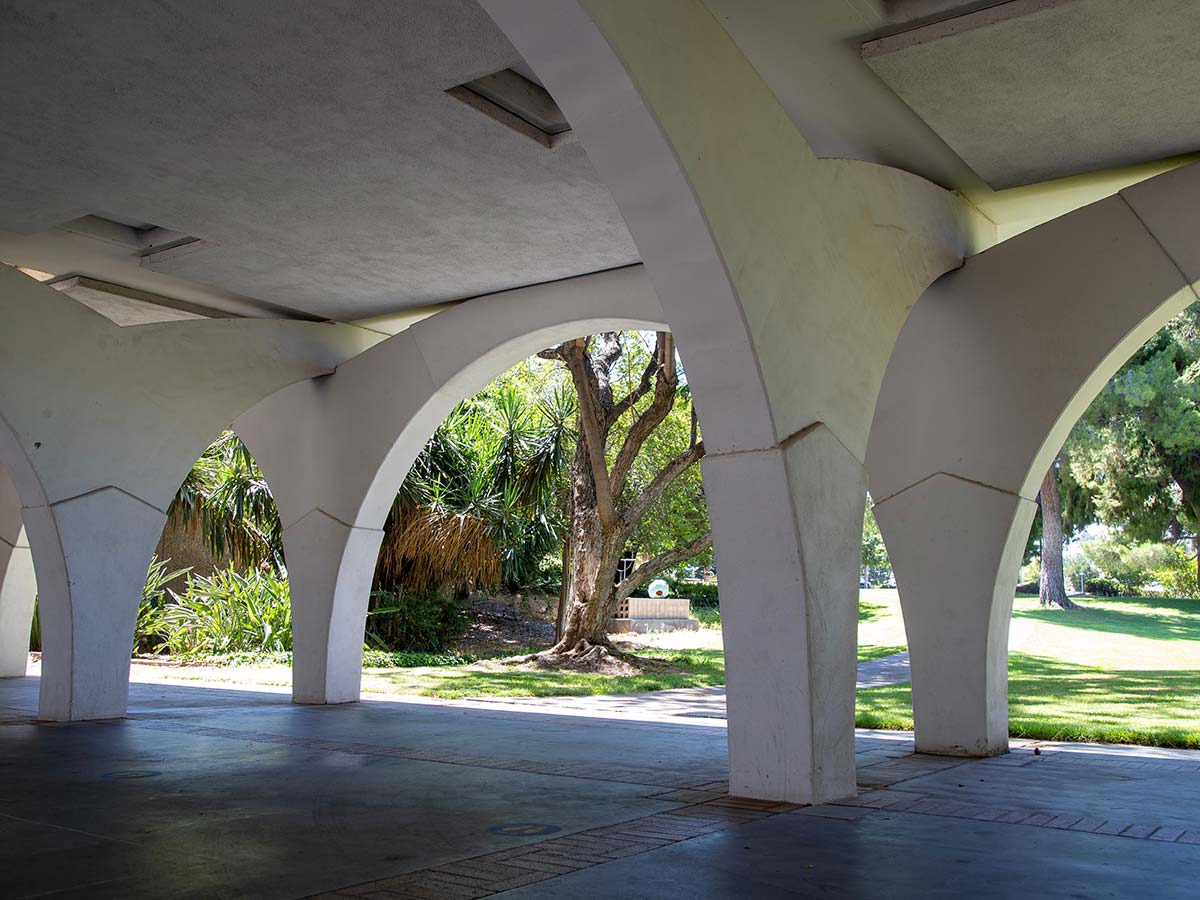
(“Genesis II”/Warner Bros. | UCR/Stan Lim)
This scene shows Hunt and Lyra-a riding horses by Olmsted. Grover notes in his blog that “some of the most beautiful scenes in ‘Genesis II’ take advantage of the picturesque forest of arches beneath Olmsted Hall.” Like Pierce, there are some notable differences that can be seen in the image of Olmsted in 1972 and now.
“Most of the waffle-like vaults in the ceiling are now covered up, and the arches look thicker at their bases, changes courtesy of retrofitting for earthquake safety,” Grover wrote in his blog.
(“Genesis II”/Warner Bros.)
In this scene, a panning shot shows Hunt and Lyra-a walking up one floor from the arches in Olmsted Hall, with the arches of the Tomás Rivera Library and the bell tower prominently in the background. Grover points out that “the tree is older but still instantly recognizable.” However, behind the bell tower, you can see the old Student Union building that predated the current UCR Bookstore and HUB now in its place.
(“Genesis II”/Warner Bros.)
The Rivera Library makes many appearances in Roddenberry’s pilot, including this scene showing Hunt and Lyra-a walking beneath the building’s distinct covered archway. As noted in Grover’s blog, the Rivera Library is fittingly home to the Eaton Collection of Science Fiction & Fantasy. While the Eaton Collection doesn’t contain items from “Genesis II,” it houses many other works related to Roddenberry himself.
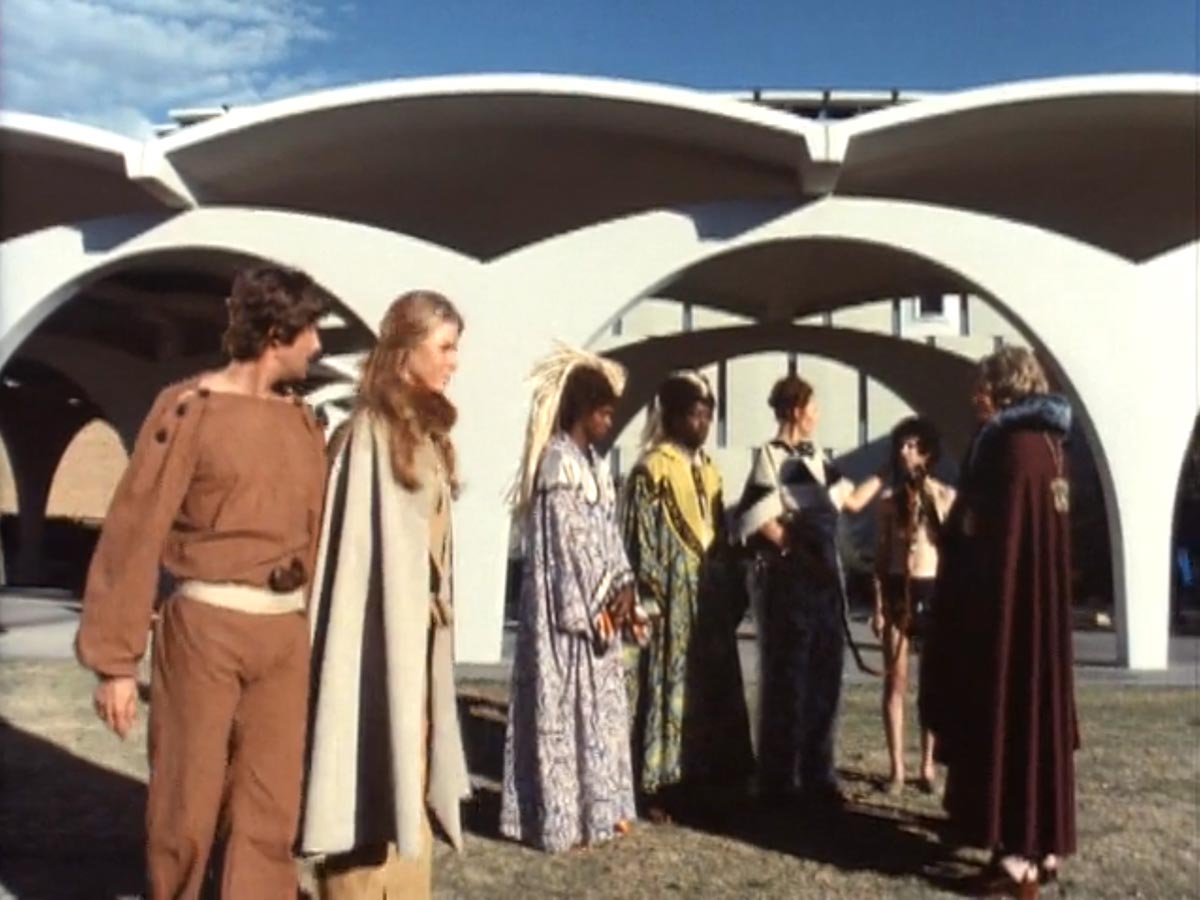
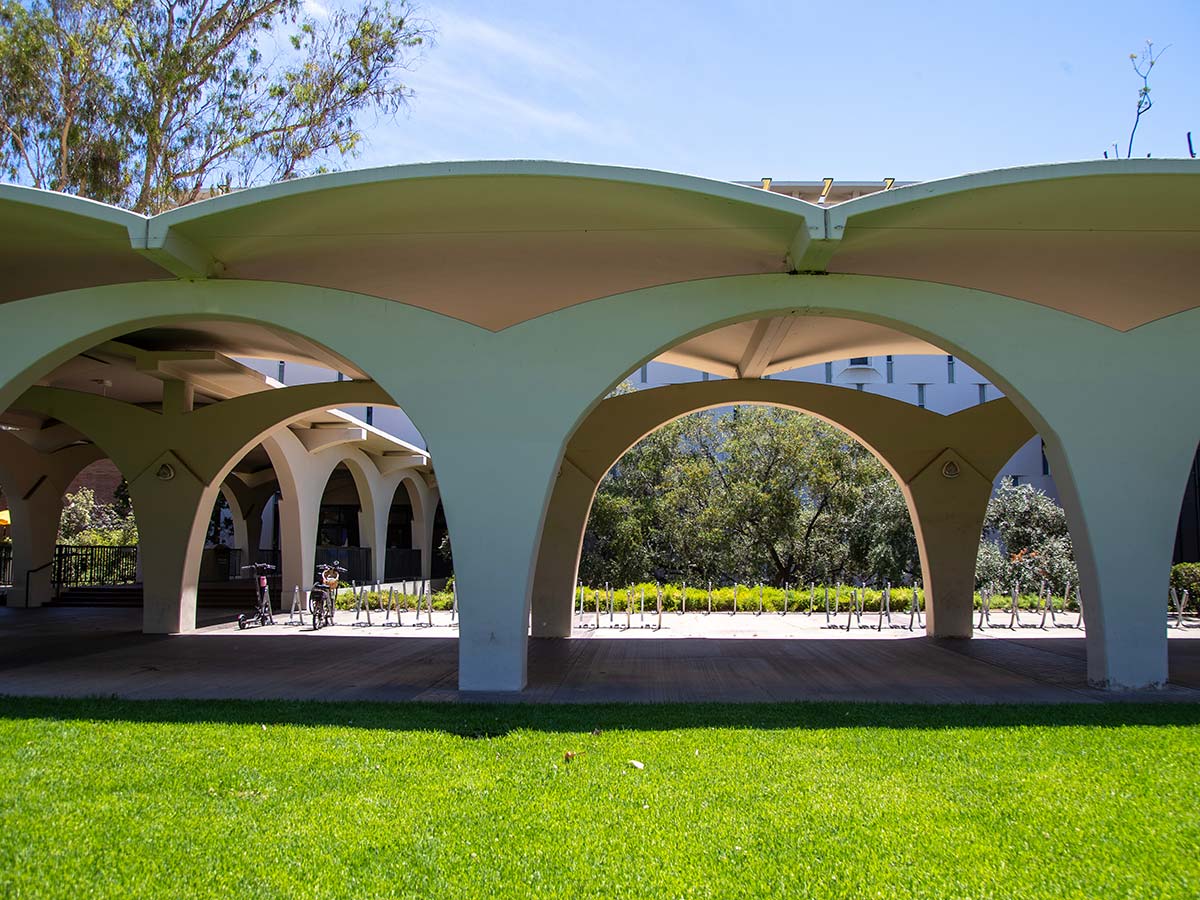
(“Genesis II”/Warner Bros. | UCR/Stan Lim)
In the scene pictured here, Lyra-a is explaining “helpers” to Hunt — non-mutant humans who are essentially slaves to the Tyranians, who believe humans to be inferior. The Rivera Library once again takes center stage, identifiable by its “unmistakable thin windows” as Grover notes in his blog.
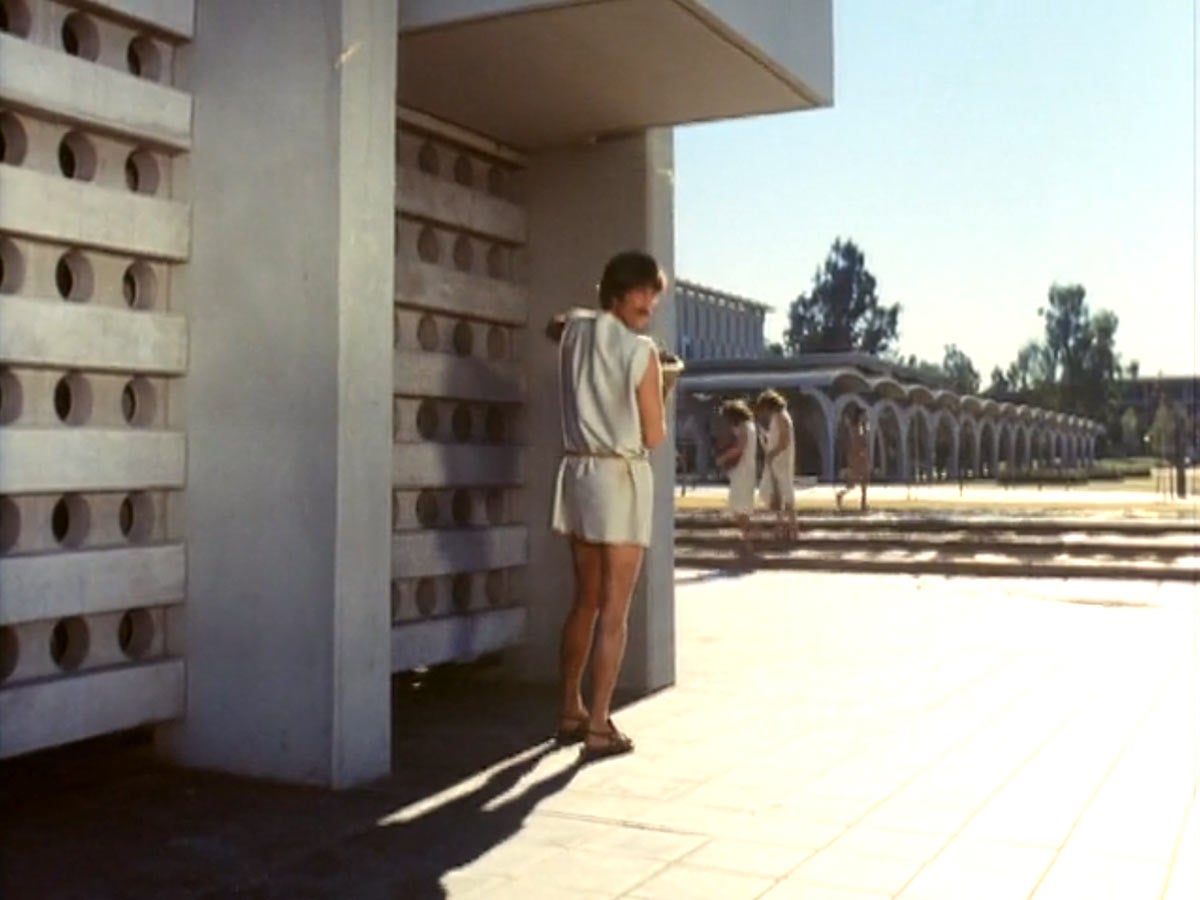
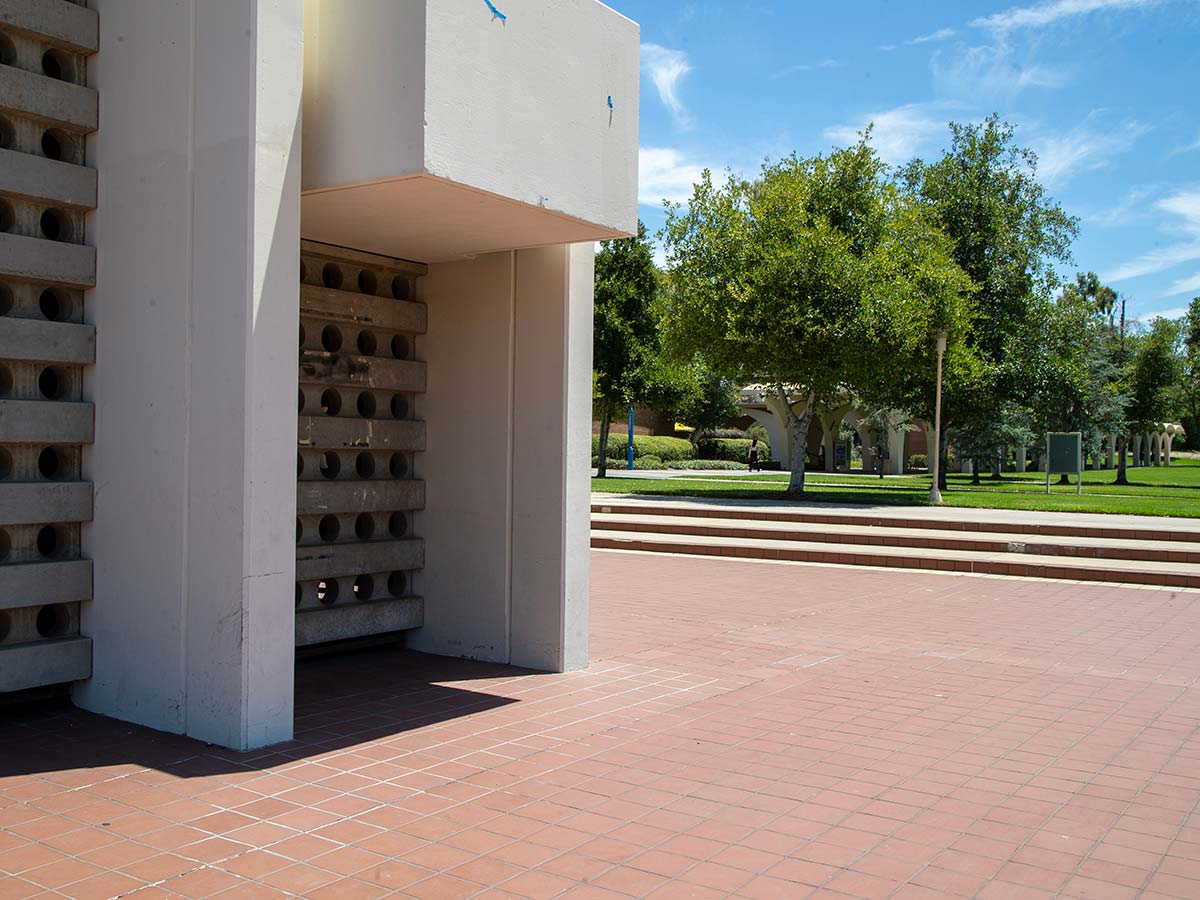
(“Genesis II”/Warner Bros. | UCR/Stan Lim)
The bell tower is instantly recognizable in this scene with Hunt walking around its base. Although it hasn’t changed much, the above photos show subtle changes to the bell tower’s structure from 1972 to today. Grover notes the thicker walls that form the tower — another example of seismic retrofitting for earthquakes, which took place years later.
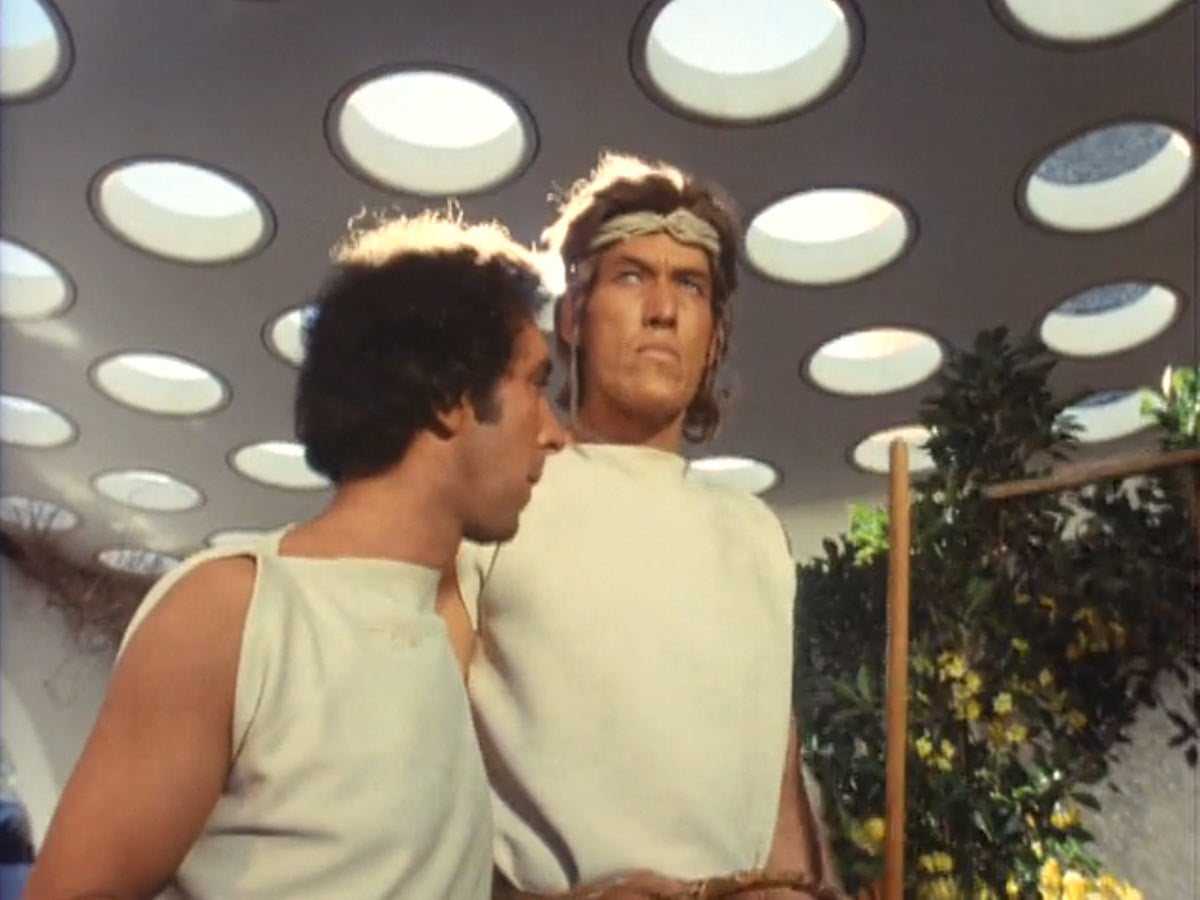
Ted Cassidy (right) plays a PAX spy infiltrating Tyrania as a helper. (“Genesis II”/Warner Bros.)
This scene features two human spies from a group known as PAX. Part of the group that originally found Hunt buried in the Carlsbad Caverns, they are on a mission to retrieve Hunt from Tyrania and return him to their society. Here they are walking under the arches outside of the University Theatre, recognizable by the circular cutouts. You may also recognize one of the actors from his role in another iconic TV series.
“Fun fact, the tall fellow is Ted Cassidy, best known for playing Lurch on ‘The Addams Family,’” Grover shared in his blog, noting he was Lurch in the original series, but not the many remakes.
(“Genesis II”/Warner Bros.)
Eventually, Hunt and the PAX spies convince the helpers to revolt against the Tyranians. The above scenes show the helpers attacking their captors as they flee the city, an epic battle that takes place on the lawn in front of the Rivera Library and the bell tower. Grover notes he suspects many of the extras in these scenes were UCR students, but after sifting through the Highlander newspaper archives, couldn’t find any information confirming their identities.
(“Genesis II”/Warner Bros.)
Here we see Hunt once again riding past Pierce Hall as the helpers make their escape from Tyrania, running across the lawn now occupied by the Bourns College of Engineering.
“Just think — my research lab occupies land once trodden by freed Tyranian slaves!” Grover wrote.
These scenes represent the last in the film with UCR as the setting, but not the end of Hunt’s adventures as he returns to the PAX society. What comes after, though, will forever be a mystery. CBS ultimately declined to pick up the series, opting to produce a “Planet of the Apes” series instead. Although “Genesis II” may have been short lived, the legacy of Tyrania and UCR’s part in Roddenberry’s sci-fi canon lives on.
To see more of UCR in “Genesis II,” you can rent or buy the movie on Amazon Prime or YouTube.
“Cannibal Women in the Avocado Jungle of Death”
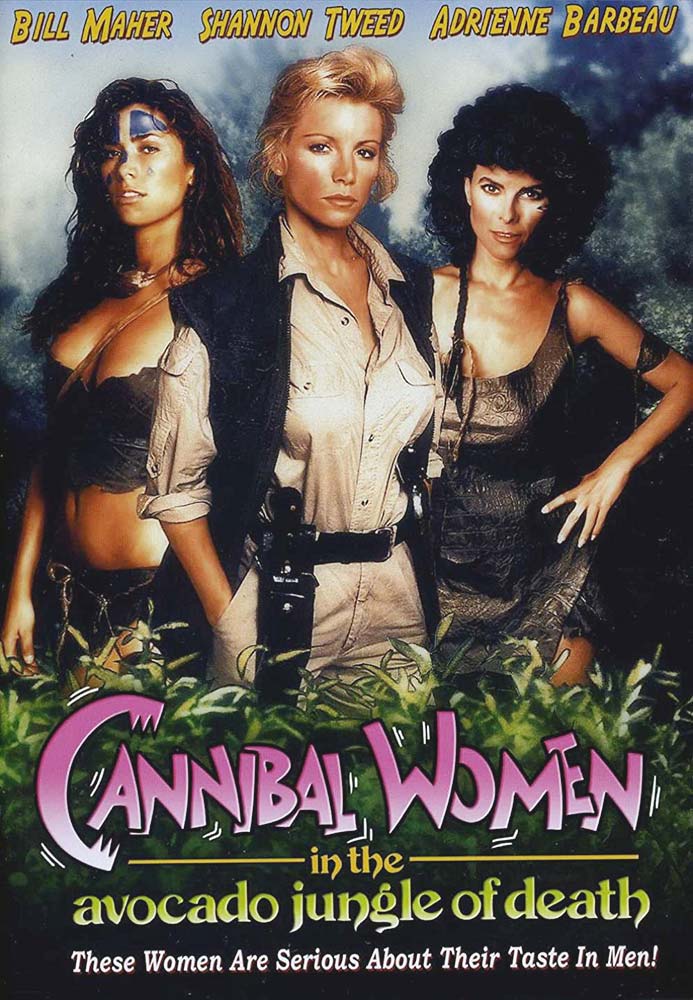
(“Cannibal Women in the Avocado Jungle of Death”/Phantom Productions)
Perhaps even more surprising than UCR’s turn as the futuristic city of an advanced, two-naveled civilization is the time it served as the setting for a treacherous jungle filled with a tribe of cannibalistic women. Before he became a well-known political satirist, Bill Maher starred in “Cannibal Women in the Avocado Jungle of Death,” a 1989 comedy filmed largely at UCR.
The movie follows Dr. Margo Hunt, a feminist studies professor played by Shannon Tweed, who is enlisted by the U.S. government to negotiate the relocation of the man-eating Piranha women residing in California’s “avocado jungle” in order to secure the nation’s vital supply of avocados. With her naive student, Bunny, in tow, she enlists the help of Jim (Bill Maher) to serve as their less-than-expert guide through the jungle. Along with UCR doubling as “Spitzer College,” much of the scenes in the film’s avocado jungle were shot in the UCR Botanic Gardens and surrounding areas.
Here are a few of the scenes featuring the UCR campus and botanic gardens, along with some avocado facts vs. movie fiction from UCR avocado expert Eric Focht.
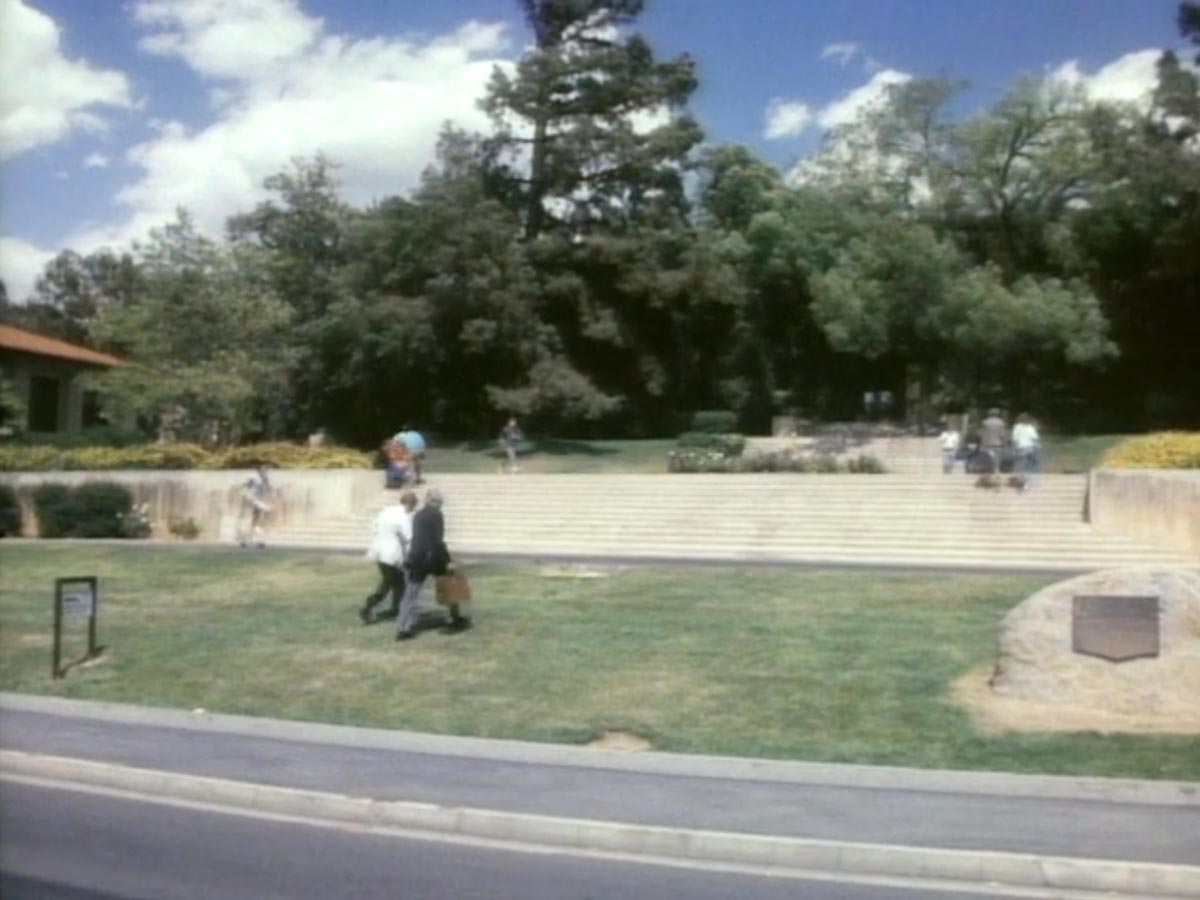
(“Cannibal Women in the Avocado Jungle of Death”/Phantom Productions)
UCR aka Spitzer College
Featured prominently in scenes like the above is UCR’s Anderson Hall, home of the School of Business — or in this case, the feminist studies department of Spitzer College. Scenes of Anderson Hall’s exterior pop up a few times in the movie, though interior shots are a mix of campus buildings. Other scenes take place in front of Olmsted Hall and outside of the Physics Building.
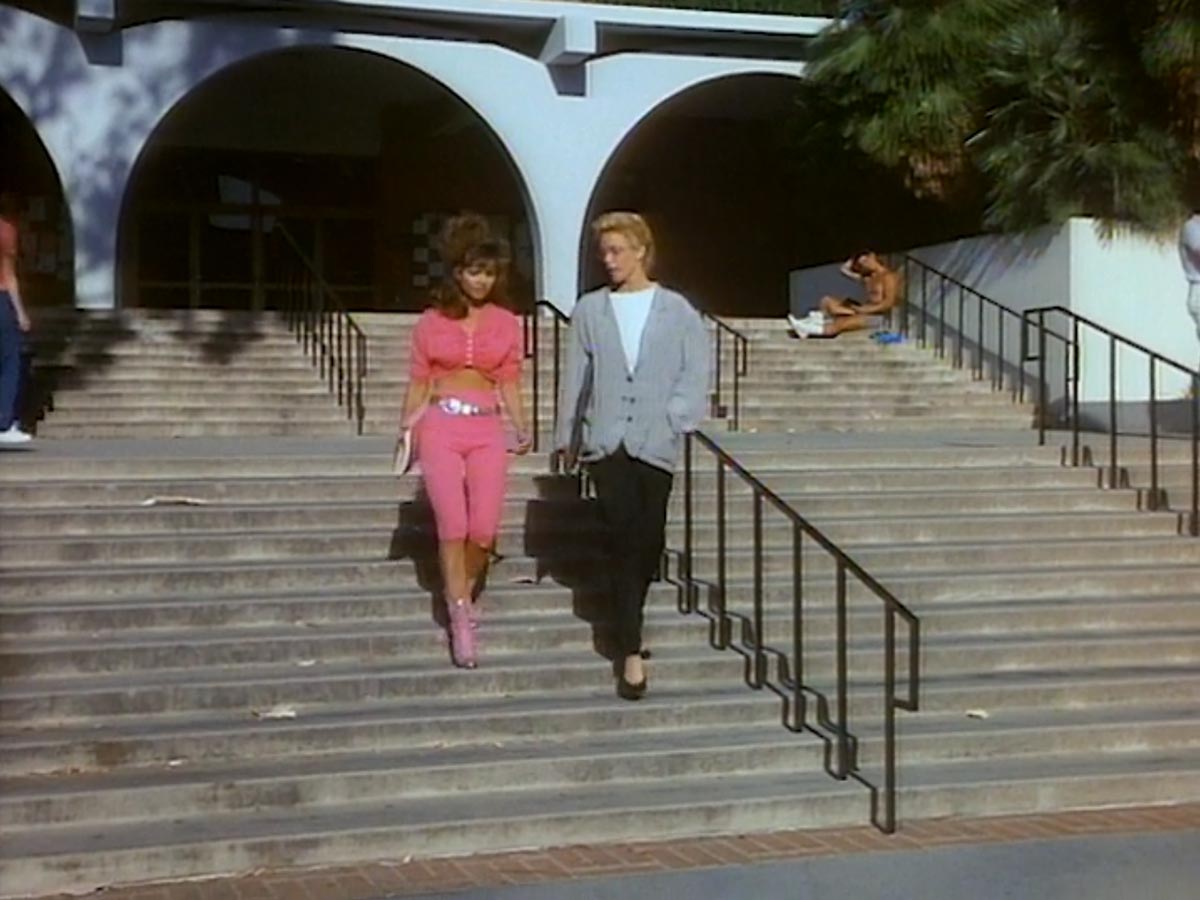
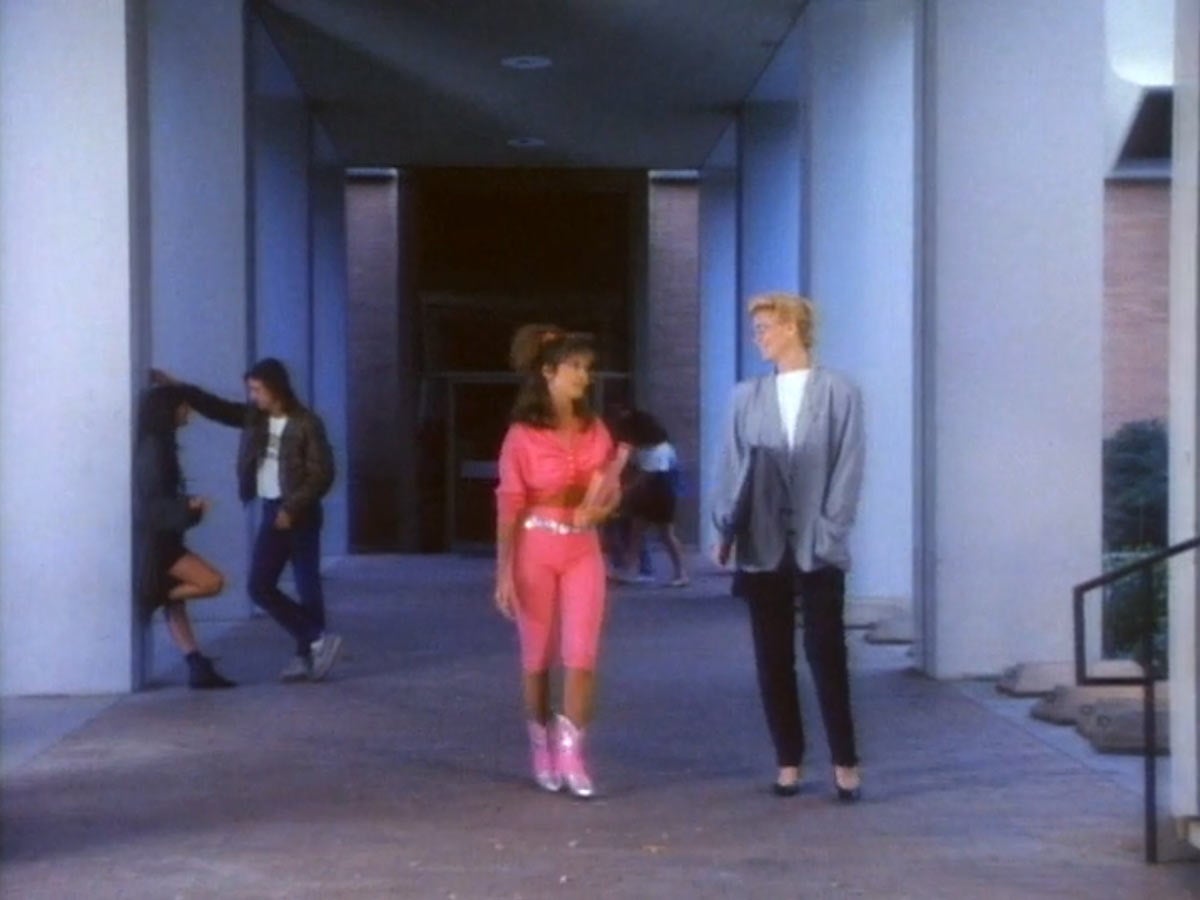
Dr. Hunt and Bunny on the steps of Olmsted Hall (left) and in front of the Physics Building’s Physics 2000 lecture Hall (right). (“Cannibal Women in the Avocado Jungle of Death”/Phantom Productions)
(“Cannibal Women in the Avocado Jungle of Death”/Phantom Productions)
Like “Genesis II,” the bell tower and Rivera Library make several appearances in the film. Here we see Dr. Hunt and Bunny (Karen M. Waldron) riding their vehicle under the Rivera Library arches, with the bell tower in the background, as they start their journey to the treacherous avocado jungle.
It’s little surprise the movie makes use of so much of the UCR campus. “Cannibal Women in the Avocado Jungle of Death” was the first film by writer, director, and producer J.F. Lawton (as J.D. Athens in the credits), son of Harry Lawton, an author and historian who founded UCR’s creative writing department and worked at the university for many years, including while the movie was being filmed. Lawton Sr. was also the author of “Willie Boy: A Desert Manhunt,” which was made into the movie “Tell Them Willie Boy Is Here” starring Robert Redford, also explored in this issue.
(“Cannibal Women in the Avocado Jungle of Death”/Phantom Productions)
The avocado jungle likely looks familiar to visitors of UCR’s Botanic Gardens. This scene here shows Dr. Hunt and Jim soon after they enter the jungle — or rather, where the annual “Primavera in the Gardens” fundraising event takes place near the garden’s entrance. While parts of the jungle were shot in areas near UCR, like the wash behind the Bannockburn student apartments, several other key jungle moments take place around the gardens, including when Dr. Hunt, Bunny, and Jim come across a village occupied by a tribe of men called the “Donnahews” or when they are discovered and captured by the Piranha women, as seen below.
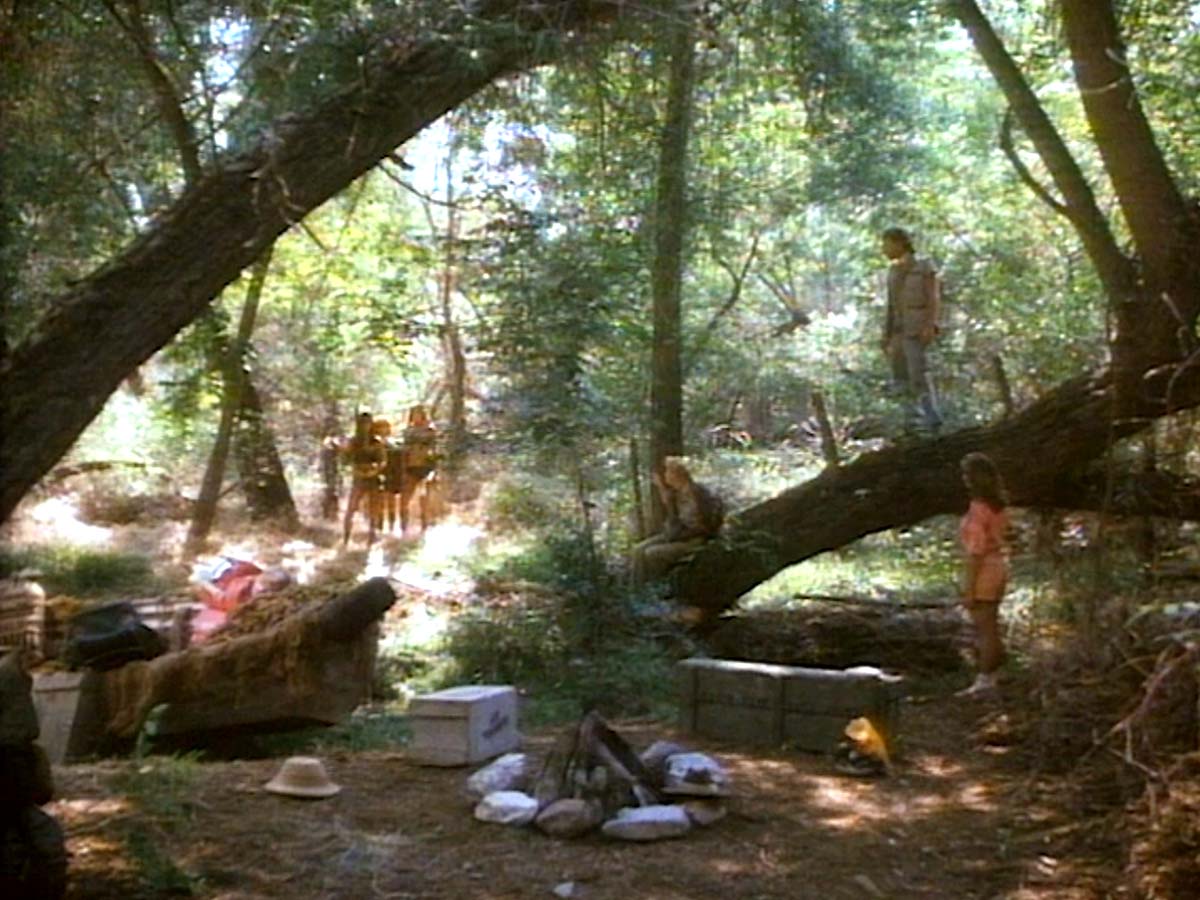
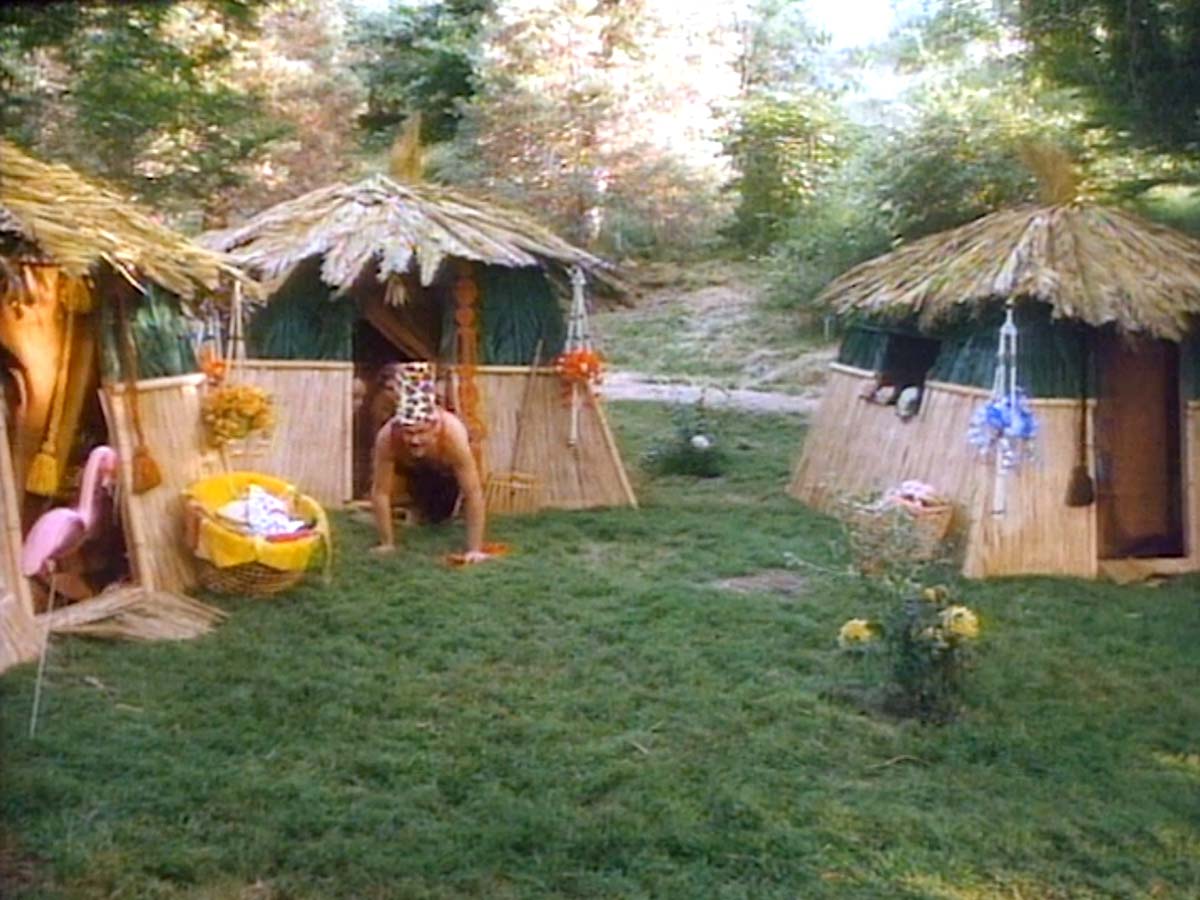
The Piranha women (left) and the “Donnahews” (right) deep in the avocado jungle. (“Cannibal Women in the Avocado Jungle of Death”/Phantom Productions)
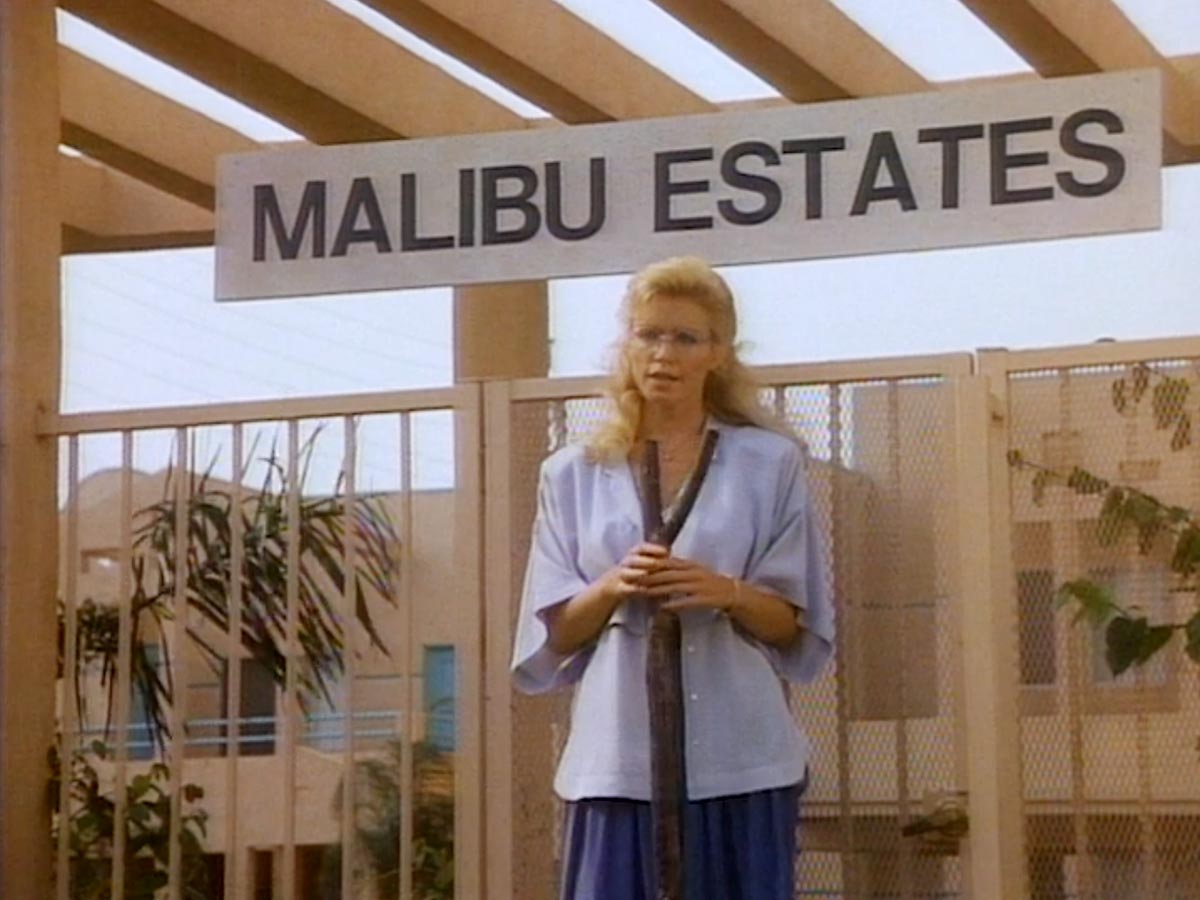
(“Cannibal Women in the Avocado Jungle of Death”/Phantom Productions)
Dr. Hunt eventually realizes the government’s ploy to move the Piranha women to a “reservation” in Malibu is much more dubious than it sounds. In this scene, she goes to confront the men at the condos, which some may recognize as UCR’s Plaza student apartments — not quite “luxury Malibu condos.” The Piranha women end up spared from being forcibly moved into “Malibu Estates,” at any rate.
(“Cannibal Women in the Avocado Jungle of Death”/Phantom Productions)
Avocado Fact or Fiction?
For a movie with “avocado” in the title, there are surprisingly few scenes in which they are featured. Although there is a lot of talk about their importance, the opening scene of the movie is among the few where one is actually seen. In it, two ill-fated men wander “deep” into the avocado jungle and spot an avocado growing on a tree, but even non-experts are likely to notice it looks a little … off.
“First off, it’s not an avocado tree that the fruit is hanging from,” said Focht, a UCR staff research associate in the botany and plant sciences department. “It looks to be a Shamel Ash or some other common Southern California ‘weed’ landscaping tree. Avocado leaves are very different than that.”
Focht notes, however, that avocado trees in general are quite varied, likely because the plant was only recently commercially domesticated. In fact, UCR’s avocado scion breeding program maintains one of the largest avocado germplasm collections in the world.
(“Cannibal Women in the Avocado Jungle of Death”/Phantom Productions)
In this scene, which some may recognize takes place in UCR’s Physics 2000 lecture hall, government officials speak with Dr. Hunt about the “avocado belt” and the supposed importance of avocados in maintaining U.S. national security. Among the many “facts” learned: 98% of the U.S.’s avocados come from California; the avocado belt stretches from Bakersfield to the border of Mexico; and Nicaragua, Guatemala, El Salvador, and even the Soviet Union are also major avocado producers.
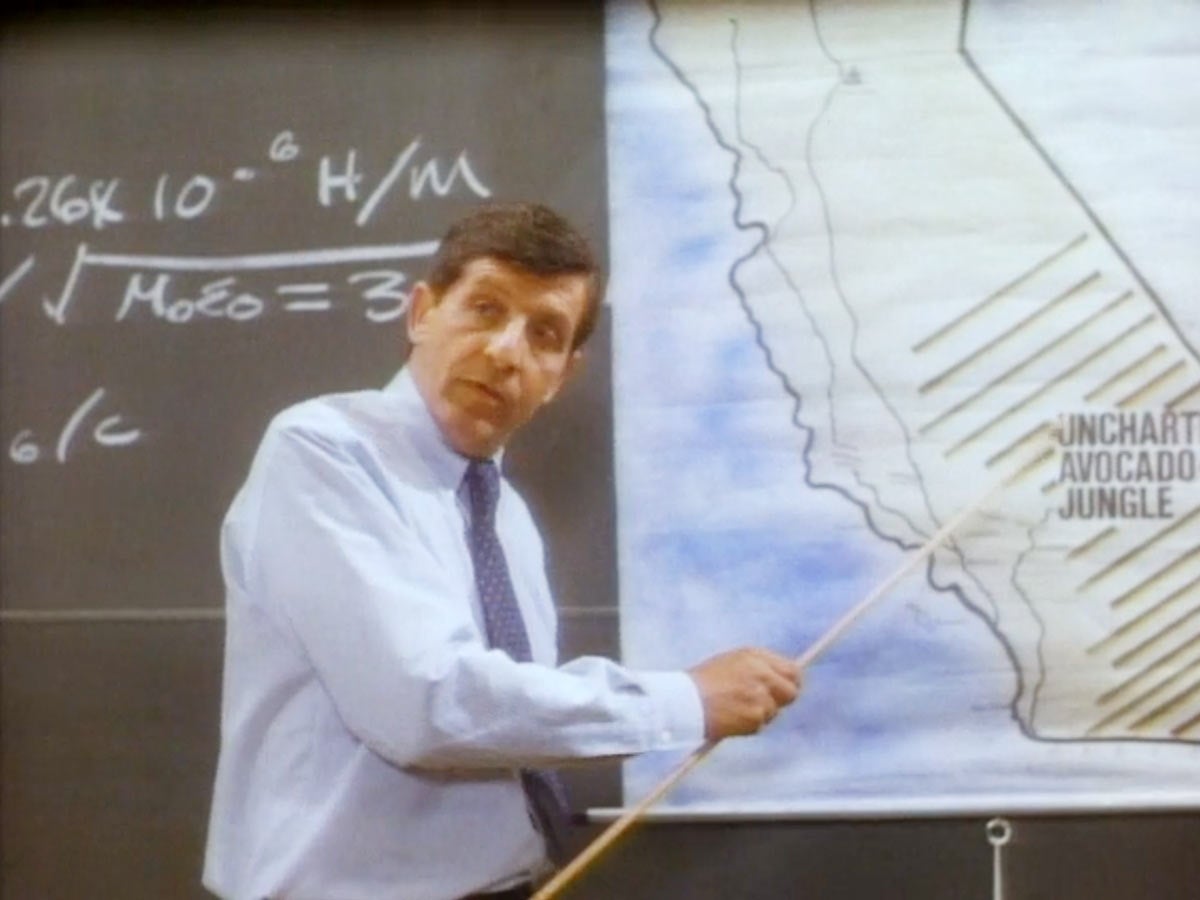
(“Cannibal Women in the Avocado Jungle of Death”/Phantom Productions)
“We know that San Bernardino, Riverside, San Diego, and Imperial counties are not jungle land, inhabited by cannibal women or otherwise, but I think the grain of truth that grew into this fantastic alternative Southern California landscape is that until fairly recently, San Diego County was the biggest avocado producing county in the state, and California does produce the most avocados in the U.S.,” Focht said, noting production has since been shifting to other areas, including Ventura County and the Central Valley.
On a global scale, Mexico is the biggest producer of Hass avocados — which dominates the commercial market — at around 60%, while the U.S. is the biggest consumer at 50%, he added. Latin America as a whole makes up around 76% of planting area by acreage, whereas California is only 4% of the global planting area. Other important importers into the U.S. market are Peru, Chile, and recently, Colombia. In terms of national security, Focht doesn’t think the U.S. has too much to worry about, at least when it comes to avocados.
“Although it’s kind of funny in this scene that the avocado colonel with his terrific stage eyepatch is very concerned about the ‘communist’ market share, the majority of the avocados grown in, for example, Cuba are of the more tropical lowland varieties that tend to do well in Caribbean and tropical climates, and these do not pose a serious threat to the ‘avocado industrial military complex’s hegemonic control over the market,” Focht said.
(“Cannibal Women in the Avocado Jungle of Death”/Phantom Productions)
Here we see Dr. Hunt, Bunny, and Jim reach the edge of the avocado jungle. Discerning viewers may notice it doesn’t exactly look like a jungle. Even Bunny makes a comment saying as much. Focht’s best guess is this was filmed at UCR’s Agricultural Operations site, noting the block of citrus growing on one side of the fields and the line of Washingtonia palms in the background.
“As for the avocado plantings to their stage left side as they pull up in the jeep, these look something like how a commercial grove would look in that they are roughly evenly spaced and in rows,” Focht said. “The trees themselves, however, are not Hass and might be composed of several other avocado varieties instead. If it was on AgOps, this was probably an experimental grove.”
In terms of their native environment, avocados don’t grow as a single block or monoculture and are part of the understory system in the neotropical forests, tending to grow up from underneath other established larger trees, he said. Focht added that avocados are originally endemic to Mexico and Central America and the first human records of them come in the form of Mayan images at a tomb in Palenque, Chiapas. It wasn’t until the 1800s that Californians started to bring up avocado seeds, but the first trees to fully grow and fruit are thought to be those of Judge Ord in Santa Barbara sometime later in the 19th century.
While it may lack accurate avocado information, Focht does admit, “on some levels, the premise of this movie is pretty outlandish and amazing.” And for his part, J.F. Lawton went on to write such hit films as “Pretty Woman,” “Under Siege,” and “Chain Reaction.” But Lawton’s first movie holds a special place in UCR history.
You can watch “Cannibal Women in the Avocado Jungle of Death” for free on Amazon Prime and Tubi.
Campus Cameos
Beyond the futuristic city of Tyrania and California’s treacherous avocado jungle, UCR has served as the backdrop to several other movies through the years. Here are more films where the campus was put in the spotlight.
“Slackers” (2002)

This comedy starring the likes of Jason Shwartzman, Devon Sawa, Jason Segal, and Jamie King follows the nerdy Ethan, played by Shwartzman, as he attempts to blackmail fellow students for cheating as a means to get closer to his crush. The film’s fictional “Holden University” is a mix of the UC Riverside campus and the University of Redlands. Watch the film on Amazon Prime.
“Boys and Girls” (2000)
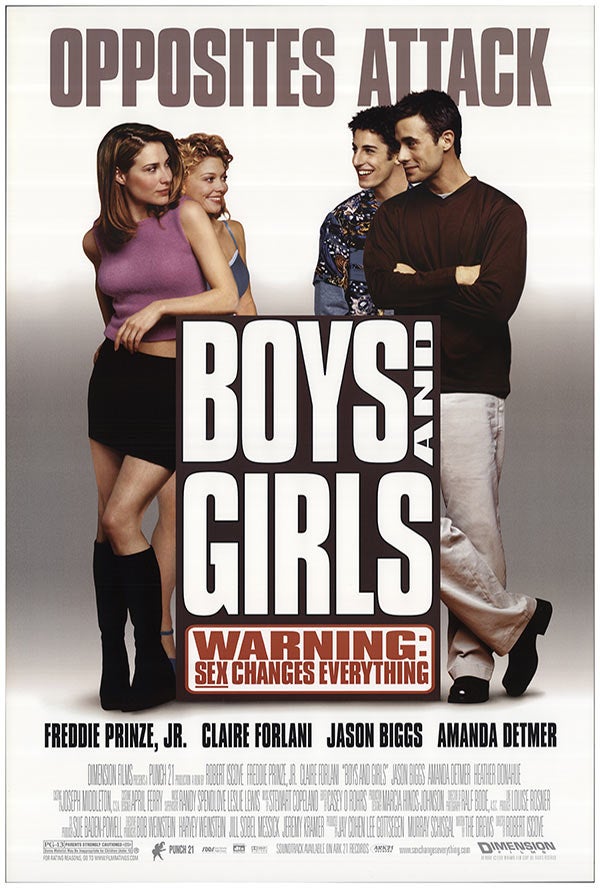
While the movie is set at UC Berkeley, you may spot some familiar UCR scenes like Orbach Library in this romantic comedy starring Freddie Prinze Jr., Jason Biggs, and Claire Forlani. At odds with one another since first meeting as adolescents, Ryan (Prinze Jr.) and Jennifer (Forlani) find they can’t escape fate, or each other. Watch the film on Paramount+.
“Bug” (1975)
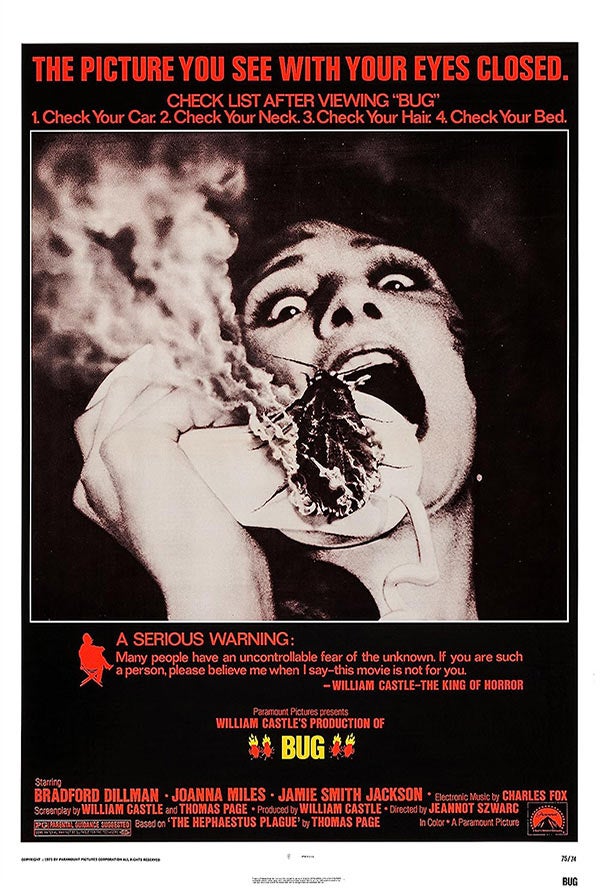
Home of one of the top entomology departments in the world, a UCR cameo is only fitting for this insect-based ’70s thriller. The final movie from horror filmmaker William Castle, “Bug” stars Bradford Dillman as a professor who becomes fascinated by a fire-starting breed of cockroaches released from their subterranean habitat after an earthquake. Watch the film on Amazon Prime.
